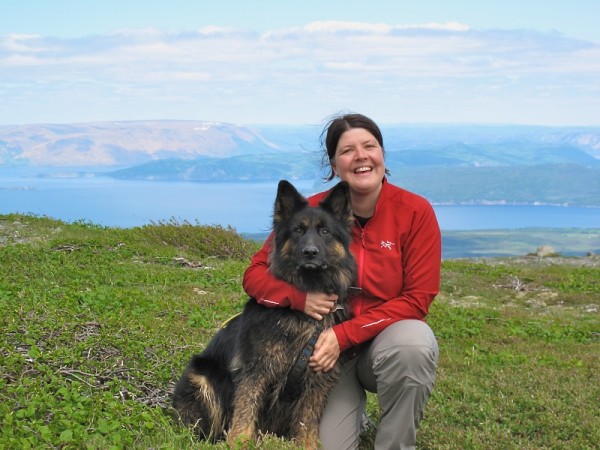Isabelle Schmelzer from Corner Brook

Isabelle with her male German Shepherd Kapvik. Isabelle writes: “Kapvik turned 7 in October. His name means ‘wolverine’..when he came to live with me I was working on a wolverine study in Labrador. Kapvik was all hair and teeth as a puppy..he’d clamp those sharp little teeth on just about everything…and the name seemed to fit.
I’ve had him since he was 9 weeks old.
“The Six Golden Questions”:
– What does your pet like?
He loves to join me on mountain bike rides, ski trips, and hikes and camping trips—he has literally covered thousands of kilometres with me all over Newfoundland and Labrador in the 7 years he has been with me.
He also loves to work—and as a German Shepherd Dog from working lines he needs a job that requires him to solve a problem along with physical exercise to be happy (and to keep him from getting into mischief). We have been training in Wilderness Search and Rescue his whole life, and the past two years we have also been training in tracking, and in Schutzhund, all of which he gets really excited about (actually—we both do!)
– What does your pet not like?
He does not like to cross metal bridges with big gaps between the slats. Even when he knows there is a big reward on the other side he’ll slowly tiptoe over the bridge with his paws splayed and belly low as though he were creeping over thin ice. It’s hard not to chuckle.
– Favourite toy?
This time of year—snowballs! There’s not much he won’t do for a series of rapidly thrown snowballs that he must leap into the air to catch in his mouth. In the summer he will jump off docks and lakeside rocks to retrieve his orange ‘bumper’ and cool off with a swim. He also loves his partially deflated soccer ball and a large tug the size of my forearm that he can wrestle with.
– Favourite food?
Any kind of raw meat! Particularly liver—and especially if it’s moose that’s been ‘seasoned’ for a few months by the side of trail…
– What have you learned since you have had your pet?
I’ve lived with dogs most of my life, and had my own dog for the past 18 years. My last dog lived to be almost 16, and died while Kapvik was still a puppy. I’ve also learned a lot from observing the dogs and training styles of fellow handlers in Search and Rescue, tracking, and Schutzhund.
With each dog I have learned how little I know! On a more serious note, If I were to pick something that applied to all these dogs and disciplines, I would say that I’ve learned to honour the (individual) dog I have and to build on their strengths in terms of the training I am doing and the activities we undertake or the pace we are training at.
Each dog, just like each person, is very different and you need to adjust accordingly. While many of us enjoy our pets as companions, I’ve also learned how great it feels when you and your dog are working as a team—whether on a track, or looking for a victim in SAR, or while hunting with a retriever or pointer—you can probably think of several examples.
You each have a job to do, and are communicating with each other—as handler you need to be able to ‘read’ the dog and teach them what their job is. And then trust them to do their part. When that ‘clicks’ it’s an incredible feeling.
– Do you have any advice for other pet owners?
Mental (training) and physical exercise can solve a lot of problem behaviours! Incorporate these two things as best you can into your day-to-day life with the dog and he or she will be relatively easy to live with.
Pick a dog suited to your personality and lifestyle—this can mean a breed, or also the age of a dog—adult dogs are often a much better fit in busy households.
Socialize them to lots of different people, places and circumstances that they will be exposed to. This will let you include them in your life more fully—even if it’s a stroll downtown, or a ride on a skidoo or ATV.
If your dog is comfortable with the routine activities of your life, he will get to spend more time with you and love you for it.
Take the time to learn a little about motivational dog training—there are lots of great resources out there in terms of videos, books, or classes. Incorporate short, fun sessions with lots of rewards (toys or food or both) into your day-to-day life, and before you know it you will have established a pattern where your dog learns to like learning, and you will have a perfect foundation on which to train obedience or anything else you would like.
Often, withholding a reward is more effective than giving a correction in shaping or proofing a behavior. Be patient, be consistent, be fair, don’t train more than one thing at a time, and most importantly—enjoy your dog!

